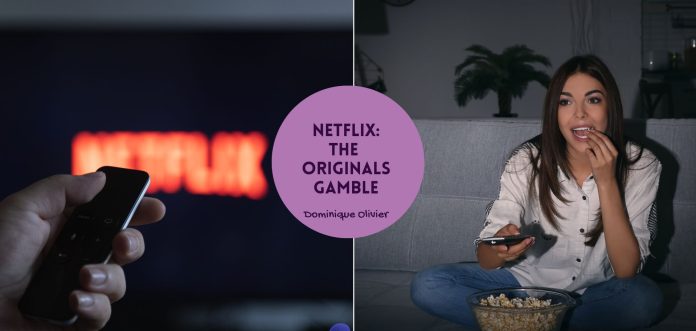2025 is set to be a big year for Netflix Originals, with viral hits like Wednesday, Squid Game and Stranger Things coming back with new seasons. But how did a streaming business decide that creating content was a better idea than licensing it in the first place – and just how expensive was that gamble?
Somewhere at the start of 2024, I heard a rumour that one of my favourite novels, Gabriel García Márquez’ One Hundred Years of Solitude, was being made into a TV series. The possibility both frightened and excited me: after all, García Márquez’ magnum opus (considered by many to be Columbia’s national poem) was deemed to be unfilmable. The author himself admitted to writing it that way on purpose, in order to prove that the written word had a wider scope than the cinema. With that, the Nobel-prize-winning author threw down the proverbial gauntlet, and in the 58 years since the novel was first published, none dared take on the challenge.
Except Netflix, of course.
I’ll admit that some of my fears around this project were relieved when I heard that it would be a Netflix Original, but I was still nervous. While Netflix doesn’t have quite the same reputation for content flops as competitor Disney does (look upon those live-actions and despair), they do have their fair share of lemons. I put my hope in the power of a juicy Netflix production budget and waited to see what would emerge.
Worth the wait
The first season of One Hundred Years of Solitude debuted in December 2024. At this point I have watched four episodes, and reader, I have not been disappointed. Not only has the series stuck to its source content (lovers of the book will recognise many of the narrated passages lifted directly off the page, word by beautiful word), but it managed to capture the weird and often baffling moments of fantasy that García Márquez is famous for weaving into the everyday. I am not alone in my reverie: as I write this article, the first season of One Hundred Years of Solitude has an 85% “Certified Fresh” rating on review aggregator Rotten Tomatoes, and an IMDb rating of 8.4 out of 10.
These positive reviews are the dividends of a serious investment. While Netflix has been unwilling to disclose exactly how much it cost to create the series, they have let slip that this is the most expensive series ever made in Latin America (putting Narcos, with its $25-million-per-season budget to shame, then). Determined to stay true to its origins, the series was shot on location in Columbia with an all-Columbian cast. Across the span of six years, the Netflix team built four different sets representing the fictional town of Macondo, populated them with dozens of fully-grown native trees, and contracted 150 communities to make thousands of handmade artifacts.
If you thought I was nervous about the outcome of this series, imagine being the Netflix executive that signed off on those expense sheets.
Why bother with originality?
Sure, the big leap into streaming in 2007 was a turning point for Netflix, but I would argue their real power move came in 2013, when they created their first Original series, House of Cards. Some would argue that this idea was just about padding their library with a few in-house productions, but in reality, it was a fundamental shift in how the company operated.
Until then, Netflix had been entirely dependent on licensing agreements with Hollywood studios, paying massive sums for the rights to stream movies and TV shows, all of which could be pulled from the platform at any time. As these deals became more expensive and unpredictable, Netflix faced a growing problem: how could it secure its future when the content it relied on wasn’t truly its own? The answer was simple – stop depending on others and start making its own content.
And so, with House of Cards, Netflix transformed from a content distributor into a fully fledged entertainment powerhouse!
Instead of relying on third-party studios, Netflix could now guarantee a steady stream of exclusive content, keeping subscribers engaged and reducing the risk of them jumping ship to competitors. This also opened the door to global expansion. Rather than being just an American company licensing Hollywood content, Netflix invested in original productions across different regions and languages, tapping into massive international audiences and proving that great storytelling wasn’t limited to a single market.
Winning Emmys and BAFTAs reinforced the message to the entertainment industry that Netflix was no longer just a streaming service, but a serious creative force. This newfound prestige made the company a magnet for top-tier directors, actors and writers who once only looked to traditional studios. Meanwhile, the move sent shockwaves through the industry, forcing legacy media giants to compete with a tech company that wasn’t playing by their rules. And as history shows, that rarely ends well for the incumbents.
The Netflix effect
Beyond changing how we watch entertainment, Netflix’s investment in Originals has reshaped pop culture itself. From fashion and music to tourism and hobbies, the platform has an uncanny ability to take niche interests and launch them into the global spotlight. This phenomenon, casually referred to as “The Netflix Effect,” is responsible for everything from chess booms to retro revivals.
Take The Queen’s Gambit, for example. When it premiered in 2020, it triggered a full-scale chess renaissance. The series, which follows the rise of fictional chess prodigy Beth Harmon, reignited worldwide interest in the centuries-old game. Almost overnight, sales of chess rule books shot up by 603%, orders for chess boards were up by 87%, and online platforms like Chess.com saw record-breaking surges in new users. But the impact wasn’t just digital. Local chess clubs reported a wave of new members, and tournaments found themselves with a fresh influx of players. The Queen’s Gambit had done something surprising: it made chess cool again.
And it’s not just chess. Stranger Things, arguably Netflix’s first Original series to go viral, became somewhat of a pop culture juggernaut. Set in the 1980s, the show’s nostalgic world-building sparked a resurgence of retro fashion, from scrunchies and mom jeans to band tees and bomber jackets. Kate Bush’s 1985 song Running Up That Hill shot to the top of the charts in 2022 after it was prominently featured in season 4, making her the solo artist with the longest gap between two number-one UK singles and the oldest female artist to achieve a UK number one. The 37-year gap between the single’s release and the time it took to reach number one also set a new world record. Meanwhile, Google searches for “how to play Dungeons and Dragons” (a recurring theme in the series) skyrocketed by 600%, while searches for “Dungeons and Dragons starter sets” jumped by 250%. Even Eggo waffles, which are the obsession of one of the main characters, saw an unexpected jump in popularity, with parent company Kellogg’s noting a 14% year-on-year increase in Eggo consumption since Stranger Things debuted.
We could argue that Stranger Things is as much a series as it is a nostalgia-powered marketing machine – one that turned an entire decade into a brand and made us all desperate to live in it. When’s the last time you saw another streaming platform get that right?
Money to burn
In the first half of 2023, 62 of the top 100 most-watched titles on Netflix were Originals. And in 2024, Netflix doubled down, pouring the “vast majority” of its hefty $17 billion content budget into Originals, even with a flood of high-profile licensed hits up for grabs.
In order to keep its subscriber numbers climbing, Netflix has to strike the right mix between splashy, big-budget productions and cost-effective licensed content. Here’s a stat to help put that pricing discrepancy into perspective: at one point Netflix was streaming IT: Chapter 1, the box-office hit based on Stephen King’s famous book. Just like Stranger Things, this film is set in the 80s and features an ensemble cast of mostly children and teenagers, with CGI used to bring a variety of monsters to life. IT was made with a budget of $35 million. In 2024, it cost Netflix $30 million to make just one episode of Stranger Things!
Spending that much money per episode might seem outrageous, but in Netflix’s world, it’s the price of staying ahead. The streaming wars are fiercer than ever, with deep-pocketed competitors like Disney+, Amazon Prime Video, and Apple TV+ all fighting for eyeballs. Netflix’s answer? Own the content, own the conversation and own the subscriber.
They don’t just want you to watch One Hundred Years of Solitude; they want it to be the thing you have to talk about. They want you to binge-watch Stranger Things and suddenly find yourself Googling “where to buy a Walkman.” They want to create cultural ripple effects so strong that ultimately, those who don’t subscribe feel like they’re missing out.
And if the past decade is anything to go by, they’ve gotten very good at doing exactly that.
About the author: Dominique Olivier

Dominique Olivier is the founder of human.writer, where she uses her love of storytelling and ideation to help brands solve problems.
She is a weekly columnist in Ghost Mail and collaborates with The Finance Ghost on Ghost Mail Weekender, a Sunday publication designed to help you be more interesting.
Dominique can be reached on LinkedIn here.





Thank you, Dominique, for the article on the Netflix Gamble. I would be looking out for future Netflix productions and watch the two that you mentioned in your article.